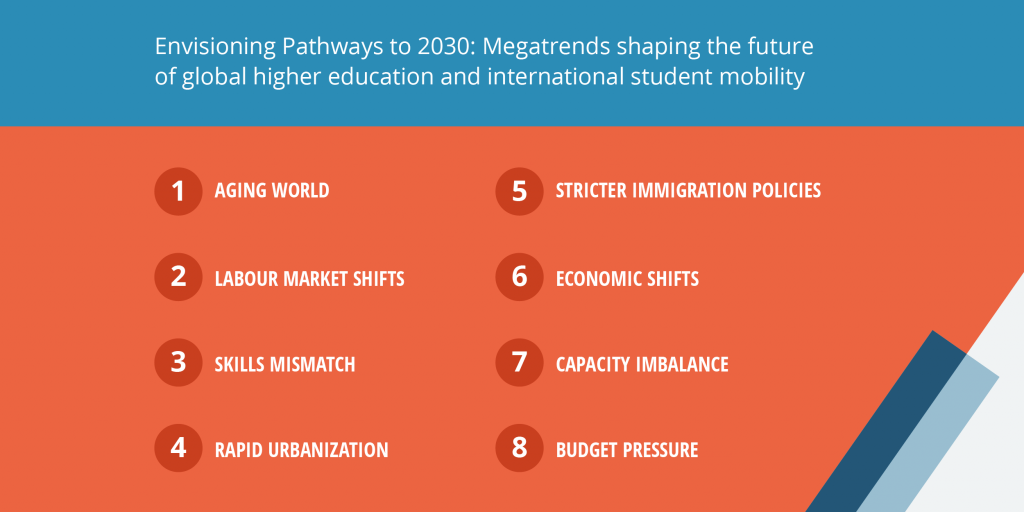New Megatrends Report on how to convert challenges within higher education into unique growth opportunities
It’s no secret that our current world is changing at rapid speed, regarding almost all facets known to man: we’re talking about automation and AI expanding the way we live today, climate change challenging our relation to our planet, social, political and economic shifts that set their mark on the fabric of society. For higher education institutions, we know that our involvement around these changes is not only needed but can be paramount to ensuring the smooth sailing society wants while going throughout these challenging times.
Considering the changes that are glimmering on the horizon, what’s next for higher education? What role should universities claim for themselves, as we walk into this fast-forward future?
To answer this pivotal question, Studyportals has just released a new report, diving into the megatrends that are shaping the future of global higher education and international student mobility. “Envisioning Pathways to 2030” is based on the analysis of current megatrends that will impact our world and aims at starting a conversation around how higher education institutions should prepare for this future. The report addresses 3 main questions:
- What are the megatrends shaping the world around us?
- How are these megatrends transforming the future of global higher education?
- What are the implications of these trends for the mobility of international students and global engagement strategies?
Especially in the context of student enrolment growth, higher education institutions should start thinking about the opportunities that these megatrends are bringing. Globally, higher education enrolment is projected to grow with wide variations within and across countries.
The report projects that tertiary enrolment will reach 332 million by 2030—an increase of 56%, or 120 million students, from 2015. Likewise, the number of internationally mobile students will reach 6.9 million by 2030—an increase of 51%, or 2.3 million students, from 2015.
Why should you look at megatrends to shape your growth strategy accordingly?
Strategy demands a certain outlook towards the future and what this can bring. Instead of checking fads or trends, which are shorter-term and more volatile, one should be more interested in exploring megatrends for their certainty, clarity, and imminence. In the end, strategy is about making choices. Identification of long-term trends in strategic choices can secure a more sustainable and successful future for their institutions. John Naisbitt defines megatrend as “a long-term, transformational process with global reach, broad scope, and a dramatic impact.” These big-scale trends are the ones you should keep an eye on because, as the Copenhagen Institute for Future Studies explains it: “Megatrends are the probable future – or express what we know with great confidence about the future. Megatrends are certainties.”
The authors of the report, Rahul Choudaha, Executive Vice-President of Global Engagement and Research, and Edwin van Rest, co-founder and CEO of Studyportals, note that the chosen theme is set in the context of the major changes happening around us on several levels, including political, technological and societal. These chosen megatrends have already proven to be the next challenges that we will have to face in the future.
Apart from the authors, the report also included perspectives from the following higher education leaders on the future scenarios for higher education institutions:
- Anant Agarwal – Founder and CEO at edX, Professor at MIT;
- Bill Barke – Retired Chairman of Pearson Higher Education North America;
- Brad Farnsworth – Vice-President at the American Council on Education;
- David Finegold – President of Chatham University;
- Elizabeth J. Stroble – President of Webster University;
- Eva Egron-Polak – Former Secretary General, Senior Fellow of International Association of Universities (IAU);
- Fernando León García – President of CETYS University System in Mexico;
- Gordon Slaven – Founder of Slaven Consultancy Services Ltd., Former Director of Higher Education Unit at the British Council;
- Huntington Lambert – Dean Continuing Education and Extension School at Harvard;
- Ken Gill – Chief Executive at NCUK (Northern Consortium UK);
- Steven Kyffin – Pro Vice-Chancellor (Business & Enterprise) at the University of Northumbria in Newcastle;
- Trevor Holmes – Vice-President of External and Strategic Affairs at Dublin City University;
- Wendy Purcell – Emeritus President at Plymouth University, Visiting Professor at Harvard.
What are the megatrends that will shape the future of global higher education and international student mobility?
-
Aging world: finding new education and employment opportunities
In the case of an aging population, one of the crucial questions higher education institutions should get answered is how can they engage this part of the population productively throughout education and employment opportunities? What meaning does the concept of lifelong learning take in this context? As journalist and education expert Mike Baker put it, “With an aging population we need to recognise the benefits for society of providing learning into old age.”
-
Labour market shifts: increasing automation to affect the global workforce
14% of the current global workforce is estimated to be affected by automation by 2030, according to McKinsey&Company. As they explain, “Automation and AI will lift productivity and economic growth, but millions of people may need to switch occupation or upgrade skills”. Within this context, how do we plan our programs and curricula, reskill this group of people and provide relevant education for them, converting them into a productive workforce?
-
Skills mismatch: the gap between what employers’ demand versus what education provides
According to the definition provided by the European Union in their “Matching skills and jobs in the European Union” report, skills mismatch refers to “the discrepancy between the qualifications and skills that individuals possess and those needed by the labour market”. In the same research piece, we’re being informed around the fact that generally, young people and third-country immigrants suffer more from over-qualification, while older workers are more at risk of skills obsolescence. This issue will become bigger and more pressing if left unattended. At the same time, the development opportunities for universities regarding programs and delivery for these vulnerable groups are huge.
-
Rapid urbanization: shift towards cities in search of jobs and career advancement
Cities as nerve centres for finding jobs and employment opportunities are becoming much more common and critical to our overall societal development. UNESCO predicts that “by 2030, it is expected that nearly 5 billion (61%) of the world’s 8.1 billion people will live in cities.” The urban population distribution will vary from region to region, but the general consensus is that cities and megacities are taking over as the go-to option for better education and employment opportunities, becoming even more important than countries. In this case, are our higher education institutions contributing economically and socially to these regions? This marks a part of the economic development role that a university could take on.
-
Stricter immigration policies: more barriers to mobility to high-income destinations
At the same time, national policies regarding immigration are getting stricter around the world, affecting especially those who are intending to move to high-income countries. This megatrend already is reflected in current world news, from the post-Brexit discussions around education and talent attraction to European countries intending to close off more borders. One of the burning questions for universities regarding this megatrend is how can they attract talent to their institutions? We’re not only referring to their student body, but also to faculty members and scholars, people who form a valuable part of the university ecosystem.
-
Economic shifts: dependence on emerging markets for economic growth
In terms of economic shifts, we’ve noticed a bigger dependence on emerging markets for economic growth. There has been a dramatic rise in the number of middle-class citizens over the past 20 years, especially in regions such as Latin America, India, and China. On the other hand, Europe and the US have shown a slower pace in their middle-class numbers. Taking this information into account, how can universities engage with this complete shift in the economic environment and spot growth opportunities for themselves?
-
Capacity imbalance: demand in emerging economies versus supply in developed economies
The discrepancy between supply and demand when it comes to talent can be felt, especially when looking at different regions. There is a huge demand for higher education in low to medium income countries, but the larger number of such institutions are located in high-income countries. As part of the global engagement strategy for higher education institutions, we’ll need to ask how universities in high-income countries can productively engage with and provide access to the people that are in countries that have a higher demand, but less access to these institutions.
-
Budget pressure: higher education is facing a decline in public funding
The last megatrend on our list opens a well-known Pandora’s box for higher education institutions: dealing with less public funds. Budget pressure is something that everyone involved in this environment faces. What we’re witnessing is a shift from government funding for university programs to individual investments. That means that we are expecting an increase in the number of students that will have to pay for their studies out of their pockets. With the public expenditure continuing to shrink, private expenditure will be more the norm within higher education, a fact that will impact student enrolment and retention.
These megatrends offer the context to look at the status quo of your higher education institution and to analyse what direction you want to take regarding your educational offer. Together with the data on how the future is changing and the related frameworks for global engagement strategies, this report provides a well-informed basis for analysis and opportunity research.
For a more in-depth overview on the context and the results of the “Envisioning Pathways to 2030” report, we’re inviting you to also watch our webinar, which was hosted by Rahul Choudaha, together with a diverse panel of experts:
- David Finegold, President of Chatham University;
- Fernando León García, President of CETYS University;
- Wendy M. Purcell, Emeritus President at Plymouth University.
Higher education institutions serve as important catalysts for society’s continuous development. By including these megatrends and proposed frameworks from the report into your strategic plans, you’re not are not only ensuring the growth and relevance of your institution but also solidifying its trust and reputation.
Mentions in the news
Megatrends Prompt Universities to Innovate and Internationalize – The EvoLLLution
Global universities unprepared for sea change ahead – University World News
StudyPortals presents view on the future of international education – The PIE News
8 global trends impacting higher ed – Deep Dive
New Report Envisions Pathways for the Future of Global Higher Education – PR Web
What changes will HE have to prepare for by 2030? – University World News
For more updates, follow us!








